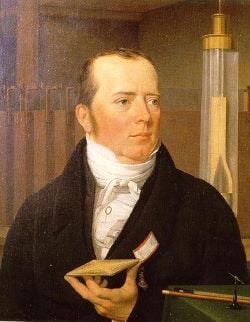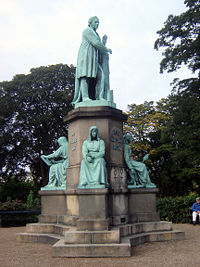Hans Christian Ørsted
| Hans Christian Ørsted |
|---|
| Born |
| August 14, 1777 Rudkøbing, Denmark |
| Died |
| March 9, 1851 Copenhagen, Denmark |
- "Ørsted" redirects here.
Hans Christian Ørsted (spelled Oersted when the Danish letter Ø is unavailable) (August 14,1777 – March 9, 1851) was a Danish physicist and chemist, influenced by the thinking of Immanuel Kant. He is best known for discovering the relationship between electricity and magnetism known as electromagnetism.
Early life and studies
Ørsted developed his interest in science while working as a young boy for his father, Søren Christian Ørsted, who owned a pharmacy. He and his brother, Anders Sandøe Ørsted, received most of their early education through self-study at home, and went to Copenhagen in 1793 to take entrance exams for Copenhagen University. The brothers passed and distinguished themselves academically at the University. By 1796, Hans Christian Ørsted received honours for his papers in both aesthetics and physics.
In 1801, he received a travel scholarship and public grant that enabled him to spend three years traveling in Europe. In Germany, he met Johann Ritter, a physicist who believed there was a connection between electricity and magnetism. The connection made sense to Ørsted since he believed in the unity of nature and that a relationship therefore must exist between most natural phenomena.
Their conversations drew Ørsted into the study of physics. He became a professor at Copenhagen University in 1806 and continued his research with electric currents and acoustics. Under his guidance the University developed a comprehensive physics and chemistry program and established new laboratories.
Electromagnetism
While preparing for an evening lecture on 21 April 1820, Ørsted developed an experiment which provided evidence that surprised him. As he was setting up his materials, he noticed a compass needle deflected from magnetic north when the electric current from the battery he was using was switched on and off. This deflection convinced him that magnetic fields radiate from all sides of a wire carrying an electric current, just as light and heat do, and that it confirmed a direct relationship between electricity and magnetism.
At the time of discovery, Ørsted did not suggest any satisfactory explanation of the phenomenon, nor did he try to represent the phenomenon in a mathematical framework. However, three months later he began more intensive investigations. Soon thereafter he published his findings, proving that an electric current produces a magnetic field as it flows through a wire. The CGS unit of magnetic induction (oersted) is named in honor of his contributions to the field of electromagnetism.
His findings resulted in intensive research throughout the scientific community in electrodynamics. They influenced French physicist André-Marie Ampère's developments of a single mathematical form to represent the magnetic forces between current-carrying conductors. Ørsted's discovery also represented a major step toward a unified concept of energy.
Ørsted was not the first person to discover that electricity and magnetism are related. He was preceded in this discovery by 18 years by Gian Domenico Romagnosi, an Italian legal scholar. An account of Romagnosi's discovery was published in 1802 in an Italian newspaper, but it was overlooked by the scientific community.
Aluminium
In 1825, Ørsted made a significant contribution to chemistry by producing aluminium for the first time.
Death and legacy
Hans Christian Ørsted died in 1851, and was buried in the Assistens Cemetery in Copenhagen.
Today, the buildings which are home to the Department of Chemistry and the Institute for Mathematical Sciences at the University of Copenhagen, are named The H.C. Ørsted Institute in his honor.
See also
- James Clerk Maxwell
- physics
| Persondata | |
|---|---|
| NAME | Ørsted, Hans Christian |
| ALTERNATIVE NAMES | |
| SHORT DESCRIPTION | Danish physicist and chemist |
| DATE OF BIRTH | August 14, 1777 |
| PLACE OF BIRTH | Rudkøbing, Denmark |
| DATE OF DEATH | March 9, 1851 |
| PLACE OF DEATH | Copenhagen, Denmark |
af:Hans Christian Oersted ast:Hans Christian Ørsted bs:Hans Christian Oersted bg:Ханс Кристиан Оерстед ca:Hans Christian Ørsted cs:Hans Christian Ørsted da:Hans Christian Ørsted de:Hans Christian Ørsted es:Hans Christian Oersted eo:Hans Christian Ørsted eu:Hans Christian Ørsted fr:Hans Christian Ørsted gl:Hans Christian Ørsted hr:Hans Christian Ørsted id:Hans Christian Oersted is:Hans Christian Ørsted it:Hans Christian Ørsted jv:Hans Christian Oersted nl:Hans Christian Ørsted ja:ハンス・クリスティアン・エルステッド no:Hans Christian Ørsted pl:Hans Christian Ørsted pt:Hans Christian Ørsted ru:Эрстед, Ганс Христиан sco:Hans Christian Ørsted sk:Hans Christian Ørsted sl:Hans Christian Ørsted sr:Ханс Кристијан Ерстед sh:Hans Christian Oersted fi:Hans Christian Ørsted sv:Hans Christian Ørsted zh:汉斯·克里斯蒂安·奥斯特

